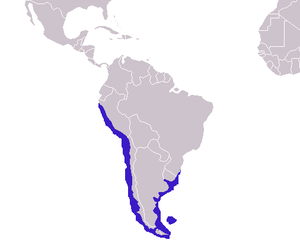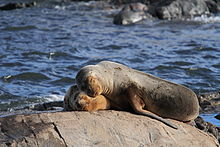Maned seal
| Maned seal | ||||||||||||
|---|---|---|---|---|---|---|---|---|---|---|---|---|

Maned seals |
||||||||||||
| Systematics | ||||||||||||
|
||||||||||||
| Scientific name of the genus | ||||||||||||
| Otaria | ||||||||||||
| Peron , 1816 | ||||||||||||
| Scientific name of the species | ||||||||||||
| Otaria flavescens | ||||||||||||
| ( Shaw , 1800) |
The maned seal ( Otaria flavescens ), also known as the South American sea lion , is a South American species of ear seals .
features
The males grow up to 2.50 m tall and weigh up to 500 kg. They are dark brown on top and yellowish brown on the underside. The eponymous mane stands out a little lighter, but is actually not a special feature of this seal, but is also present in other ear seals. By contrast, cows are only two meters long and weigh 140 kg. They are light brown in color and often have large, irregular spots spread all over the body.
distribution
The distribution area extends along the Pacific coast of South America from Peru to Tierra del Fuego and along the Atlantic coast to southern Brazil . In the South Atlantic there is also a colony on the Falkland Islands . Migratory animals have been seen far from the colonies on the Galápagos Islands and off the coast of Brazil , but these were very rare exceptions. In the vast majority of cases, these sea lions stay close to their colonies.
Way of life
The reproductive behavior is similar to that of other ear seals: the bulls arrive on the coast in front of the cows and fight for territory. In these fights, the opponents face each other and try to bite each other. This often leads to bloody injuries. The weaker males are pushed to the edge of the colony in the course of these confrontations, while the strongest claim the attractive places in the middle. If the females follow, they belong to the harem of the bull in whose territory they went ashore. A harem can contain up to 18 females, with fewer towards the edge of the colony. However, the average is only three cows per bull. The males are constantly busy preventing females from leaving the territories, for which they follow them and thereby get into conflict with neighboring bulls again. Young bulls sometimes form groups of up to ten animals that regularly enter the colony and attempt to abduct and mate with females. During the two to three months on land, a bull hardly gets any sleep or food.
The females give birth to a young after a gestation period of approx. 350 days. The birth takes place immediately after the female goes ashore and shortly before mating again with a male.
Threat and protection
For leather and oil, the South American sea lions were killed en masse in past centuries, so that the population fell from several million to a few tens of thousands. Today there are 270,000 maned seals again, with the populations steadily increasing, especially on the coasts of Argentina and Chile , while there are still declines in Uruguay and the Falkland Islands.

Taxonomy
There are currently two scientific names for the maned seal : Otaria byronia ( Blainville 1820 ) and Otaria flavescens ( Shaw 1800 ). According to the rules of the International Code of Zoological Nomenclature (ICZN), the older name is actually valid, it would be flavescens . However, in 1800 Shaw described a young animal and named it Phoca flavescens , the characteristics of which do not fit well with the maned seal , so that some zoologists reject the assignment to the maned seal and therefore consider byronia to be the first description and thus the valid name. Both names have their proponents, who like to call the other name "out of date". An arbitration ruling by the International Commission on Zoological Nomenclature to clarify the issue is still pending.
literature
- Ronald M. Nowak: Walker's Mammals of the World. Johns Hopkins University Press, 1999, ISBN 0-8018-5789-9 .
Web links
- Otaria byronia in the endangered Red List species the IUCN 2006. Posted by: Seal Specialist Group, 1996. Retrieved on 12 May, 2006.
Individual evidence
- ↑ Maned Seal - Association of Zoological Gardens (VdZ) eV . ( zoodirektoren.de [accessed on March 6, 2017]).

